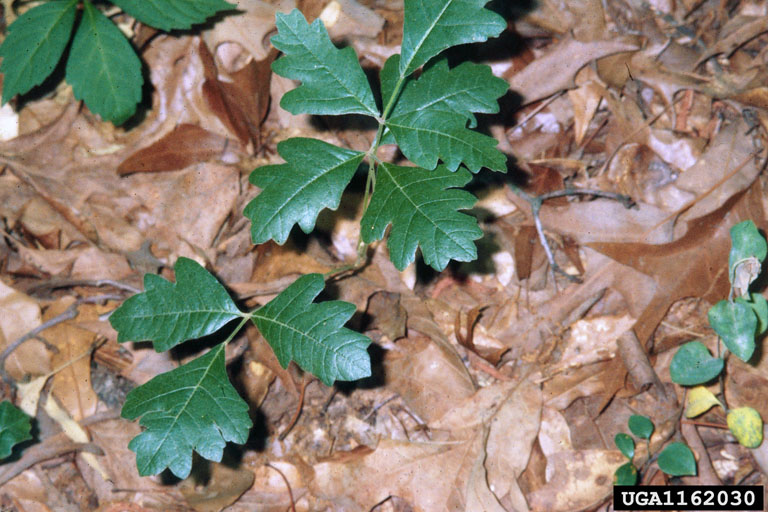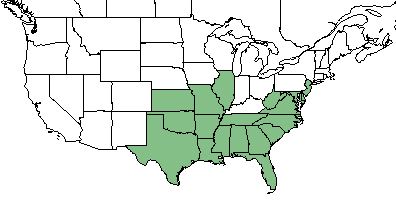Difference between revisions of "Toxicodendron pubescens"
(→Taxonomic Notes) |
(→Ecology) |
||
| Line 37: | Line 37: | ||
<!--===Fire ecology===--> <!--Fire tolerance, fire dependence, adaptive fire responses--> | <!--===Fire ecology===--> <!--Fire tolerance, fire dependence, adaptive fire responses--> | ||
<!--===Pollination===--> | <!--===Pollination===--> | ||
| − | + | ||
| + | ===Use by animals=== <!--Herbivory, granivory, insect hosting, etc.--> | ||
| + | ''T. pubescens'' consists of 10-25% of the diet of large mammals and 2-5% of the diet of small mammals and terrestrial birds.<ref name="USDA"/> Humans are studying the homeopathic abilities of ''Toxicodendron pubescens'' dilutions in anti-arthritic and anti-inflamation treatments.<ref>Patil C. R., Rambhade A. D., Jadhav R. B., Patil K. R., Dubey V. K., Sonara B. M., and Toshniwal S. S. (2011). Modulation of arthritis in rats by ''Toxicodendron pubescens'' and its homeopathic dilutions. Homeopathy 100(3):131-137.</ref> | ||
<!--==Diseases and parasites==--> | <!--==Diseases and parasites==--> | ||
Revision as of 14:52, 21 December 2017
| Toxicodendron pubescens | |
|---|---|

| |
| Photo by David J. Moorhead, University of Georgia, Bugwood.org hosted at Forestryimages.org | |
| Scientific classification | |
| Kingdom: | Plantae |
| Division: | Magnoliophyta - Flowering plants |
| Class: | Magnoliopsida - Dicots |
| Order: | Sapindales |
| Family: | Anacardiaceae |
| Genus: | Toxicodendron |
| Species: | T. pubescens |
| Binomial name | |
| Toxicodendron pubescens Mill. | |

| |
| Natural range of Toxicodendron pubescens from USDA NRCS Plants Database. | |
Common Name(s): poison oak[1], Atlantic poison oak[2]
Contents
Taxonomic Notes
Synonym(s): Rhus toxicodendron; T. toxicodendron; T. toxicarium; T. quercifolium[1][2]; R. acutiloba; R. toxicarium[2]
Description
Distribution
Toxicodendron pubescens can be found from Long Island, NY south to north Florida, west to eastern Texas and inland to West Virginia, Tennessee, Missouri, and Kansas.[1]
Ecology
Habitat
This species is very common in sandhills but can also be found in dry woodlands and dry rock outcrops in the Piedmont and mountains.[1]
Phenology
T. pubescens flowers from late April through May and fruits from August through October.[1]
Use by animals
T. pubescens consists of 10-25% of the diet of large mammals and 2-5% of the diet of small mammals and terrestrial birds.[2] Humans are studying the homeopathic abilities of Toxicodendron pubescens dilutions in anti-arthritic and anti-inflamation treatments.[3]
Conservation and Management
Cultivation and restoration
Photo Gallery
References and notes
- ↑ 1.0 1.1 1.2 1.3 1.4 Weakley A. S.(2015). Flora of the Southern and Mid-Atlantic States. Chapel Hill, NC: University of North Carolina Herbarium.
- ↑ 2.0 2.1 2.2 2.3 USDA, NRCS. (2016). The PLANTS Database (http://plants.usda.gov, 21 December 2017). National Plant Data Team, Greensboro, NC 27401-4901 USA.
- ↑ Patil C. R., Rambhade A. D., Jadhav R. B., Patil K. R., Dubey V. K., Sonara B. M., and Toshniwal S. S. (2011). Modulation of arthritis in rats by Toxicodendron pubescens and its homeopathic dilutions. Homeopathy 100(3):131-137.